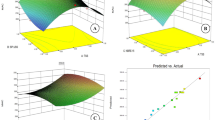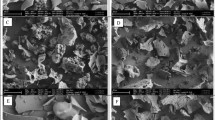Abstract
Grape seed extract (GSE) contain phenolic compounds that decrease the proclivity to various chronic diseases such as several types of cancer and cardiovascular diseases. The objective of the present study was to investigate the encapsulation of GSE polyphenols and their characterization. For this study, whey protein concentrate (WPC), maltodextrin (MD) and gum arabic (GA) were evaluated as encapsulating materials. For the preparation of stable microcapsules different WPC:MD/GA (5:0, 4:1, 3:2 and 0:5) ratios were assessed using ultrasonication for different time periods (20–40 min) followed by freeze drying. Encapsulation efficiency, antioxidant activity, particle size, surface morphology and release mechanism were determined. The GSE microcapsules coated with WPC:MD/GA ratio of 4:1 and 3:2 with core to coat ratio of 1:5 and prepared by sonication for 30 min were found to have highest encapsulation efficiency (87.90–91.13%) and the smallest particle size with maximum retention of antioxidant activity. Under optimized conditions, the low level release (43–49%) of phenolic compounds resulted under simulated gastric condition and significantly (p < 0.05) increased (88–92%) under simulated intestinal condition. Thus the results indicated blending of MD or GA with WPC improved the microencapsulation of GSE.

Similar content being viewed by others
References
Alftren J, Penarrieta JM, Bergenstahl B, Nilsson L (2012) Comparison of molecular and emulsifying properties of gum arabic and mesquite gum using asymmetrical flow field-flow fractionation. Food Hydrocoll 26:54–62
Berendsen R, Guell C, Ferrando M (2015) A procyanidin-rich extract encapsulated in water-in-oil-in-water emulsions produced by premix membrane emulsification. Food Hydrocoll 43:636–648
Chamorro S, Goni I, Viveros A, Hervert-Hernandez D, Brenes A (2012) Changes in polyphenolic content and antioxidant activity after thermal treatments of grape seed extract and grape pomace. Eur Food Res Technol 234(1):147–155
Cilek B, Luca A, Hasirci V, Sahin S, Sumnu G (2012) Microencapsulation of phenolic compounds extracted from sour cherry pomace: effect of formulation, ultrasonication time and core to coating ratio. Eur Food Res Technol 235:587–596
Davidov-Pardo G, Arozarena I, Marín-Arroyo MR (2011) Stability of polyphenolic extracts from grape seeds after thermal treatments. Eur Food Res and Technol 232(2):211–220
Delmas T, Piraux H, Couffin AC, Texier I, Vine F, Poulin P, Cates ME, Bibette J (2011) How to prepare and stabilize very small nanoemulsions. Langmuir 27:1683–1692
Desai KGH, Park HJ (2005) Recent developments in microencapsulation of food ingredients. Dry Technol 23:1361–1394
Drusch S, Schwarz K (2006) Microencapsulation properties of two different types of noctenyl succinate- derivatised starch. Eur Food Res Technol 222:155–164
Ersus S, Yurdagel U (2007) Microencapsulation of anthocyanin pigments of black carrot (Daucus carota L.) by spray drier. J Food Eng 80:805–812
Estevez M, Guell C, Lamo-Castellvi SD, Ferrando M (2019) Encapsulation of grape seed phenolic-rich extract within W/O/W emulsions stabilized with complexed biopolymers: evaluation of their stability and release. Food Chem 272:478–487
Farrag A, Mohammed El-Messery T, Mohamed El-Said M, Soliman TN, Mohamed Fakhr El-Din H (2018) Microencapsulation of grape phenolic compounds using whey proteins as a carrier vehicle. J Biol Sci 18(7):373–380
Fernandes RVB, Botrel DA (2014) Gum arabic/starch/maltodextrin/inulin as wall materials on the microencapsulation of rosemary essential oil. Carbohyd Polym 101:524–532
Ferrari CC, Germer SPM, Alvim ID, Vissotto FZ, Aguirre JM (2012) Influence of carrier agents on the physicochemical properties of blackberry powder produced by spray drying. Int J Food Sci Technol 47:1237–1245
Gabasa AL, Telisb VRN, Sobrala PJA, Telis-Romerob J (2007) Effect of maltodextrin and arabic gum in water vapor sorption thermodynamic properties of vacuum dried pineapple pulp powder. J Food Eng 82(2):246–252
Gharsallaoui A, Roudaut G, Chambin O, Andree Voilley A, Saure R (2007) Applications of spray-drying in microencapsulation of food ingredients: an overview. Food Res Int 40(9):1107–1121
Gibis M, Thellmann K, Thongkaew C, Weiss J (2014) Interaction of polyphenols and multilayered liposomal-encapsulated grape seed extract with native and heat-treated proteins. Food Hydrocoll 41:119–131
Hur SJ, Decker EA, Mcclements DJ (2009) Influence of initial emulsifier type on microstructural changes occurring in emulsified lipids during in vitro digestion. Food Chem 114(1):253–262
Jafari SM, He Y, Bhandari B (2007a) Production of sub-micron emulsions by ultrasound and microfluidization techniques. J Food Engg 82:478–488
Jafari SM, He Y, Bhandari B (2007b) Role of powder particle size on the encapsulation efficiency of oils during spray drying. Dry Technol 25:1091–1099
Kammerer D, Claus A, Carle R, Scheiber A (2004) Polyphenol screening of pomace from red and white grape varieties (Vitis vinifera L.) by HPLCDAD- MS/MS. J Agric Food Chem 52:4360–4367
Kaushik V, Roos YH (2007) Limonene encapsulation in freeze drying of gum Arabic–sucrose–gelatin systems. LWT Food Sci Technol 40(8):1381–1391
Krishnan S, Kshirsagar AC, Singhal RS (2005) The use of gum arabic and modified starch in the microencapsulation of a food flavoring agent. Carbohydr Polym 62:309–315
McClements DJ (2005) Food emulsions: principles, practice and techniques, 2nd edn. CRC Press, Boca Raton. ISBN-13: 9780849320231
McRae JM, Kennedy JA (2011) Wine and grape tannin interactions with salivary proteins and their impact on astringency: a review of current research. Molecules 16(3):2348–2364
Perez-Alonso C, Fabela-Moron MF, Guadarrama-Lezama AY, Barrera-Pichardo JF, Alamilla-Beltran L, Rodriguez-Huezo ME (2009) Interrelationship between the structural features and rehydration properties of spray dried manzano chilli sauce microcapsules. Rev Mex Ing Quim 8(2):187–196
Rice-Evans C, Miller N, Paganga G (1997) Antioxidant properties of phenolic compounds. Trends Plant Sci 2:152–159
Sansone F, Picerno P, Mencherini T, Villecco F, D’Ursi AM, Aquino RP, Lauro MR (2011) Flavonoid microparticles by spray-drying: influence of enhancers of the dissolution rate on properties and stability. J Food Eng 103:188–196
Seeram NP, Heber D (2006) Impact of berry phytochemicals on human health: effects beyond antioxidation. In Lipid oxidation and antioxidants: chemistry, methodologie and health effects; ACS symposium series. Oxford University Press, New York
Seok JS, Kim JS, Kwak HS (2003) Microencapsulation of water-soluble isoflavone and physico-chemical property in milk. Arch Pharmacal Res 26:426–431
Sheu TY, Rosenberg M (1995) Microencapsulation by spray drying ethyl caprylate in whey protein and carbohydrate wall systems. J Food Sci 60(1):98–103
Sheu TY, Rosenberg M (1998) Microstructure of microcapsules consisting of whey proteins and carbohydrates. J Food Sci 63(3):491–494
Souza VB, Thomazini M, Balieiro JCC, Favaro-Trindade CS (2015) Effect of spray drying on the physicochemical properties and color stability of the powdered pigment obtained from vinification byproducts of the Bordo grape (Vitis labrusca). Food Bioprod Process 93:39–50
Thevenet F (1988) Acacia gums: stabilizers for flavor encapsulation. In: Risch SJ, Reineccius GA (eds) Flavour encapsulation. ACS symposium series 370, American Chemical Society, Washington, DC, pp 37–44
Williams WB, Cuvelier M, Berset C (1995) Use of free radical method to evaluate antioxidant activity. LWT Food Sci Technol 28:25–30
Yadav K, Bajaj RK, Mandal S, Saha P, Mann B (2018) Evaluation of total phenol content and antioxidant properties of encapsulated grape seed extract in yoghurt. Int J Dairy Technol 71(1):96–104
Young SL, Sarda X, Rosenberg M (1993) Microencapsulating properties of whey proteins. 1. Microencapsulation of anhydrous milk fat. J Dairy Sci 76:2868–2877
Zhang Q, Zhang J, Shen J, Silva A, Dorothy AD, Colin JA (2006) Simple 96-well microplate method for estimation of total polyphenol content in seaweeds. J Appl Phycol 18:445–450
Acknowledgements
The first author is highly thankful to the ICAR-National Dairy research Institute, Karnal for the financial support in the form of Institutional Fellowship received during her Ph.D. programme.
Author information
Authors and Affiliations
Corresponding author
Additional information
Publisher's Note
Springer Nature remains neutral with regard to jurisdictional claims in published maps and institutional affiliations.
Rights and permissions
About this article
Cite this article
Yadav, K., Bajaj, R.K., Mandal, S. et al. Encapsulation of grape seed extract phenolics using whey protein concentrate, maltodextrin and gum arabica blends. J Food Sci Technol 57, 426–434 (2020). https://doi.org/10.1007/s13197-019-04070-4
Revised:
Accepted:
Published:
Issue Date:
DOI: https://doi.org/10.1007/s13197-019-04070-4




